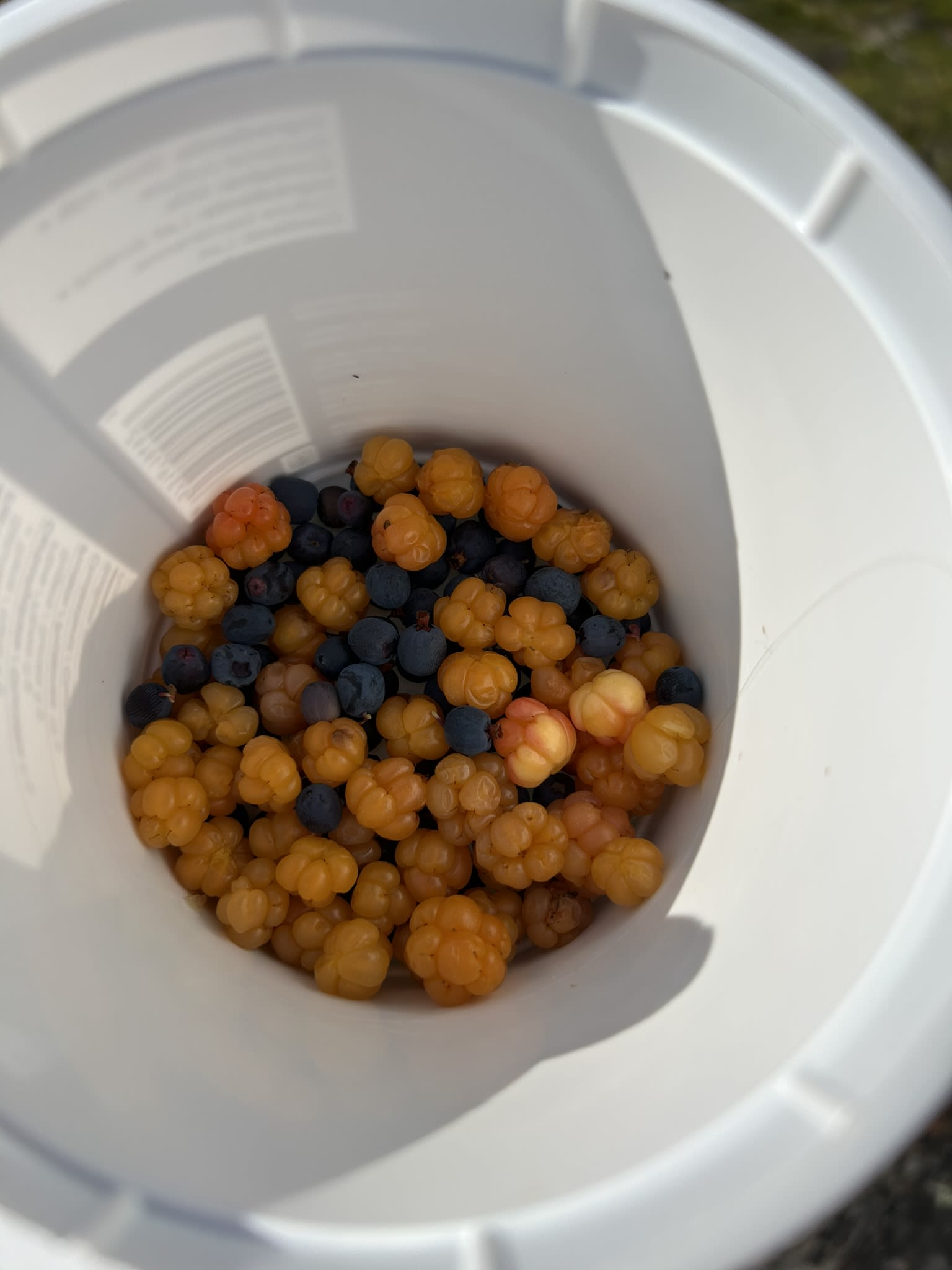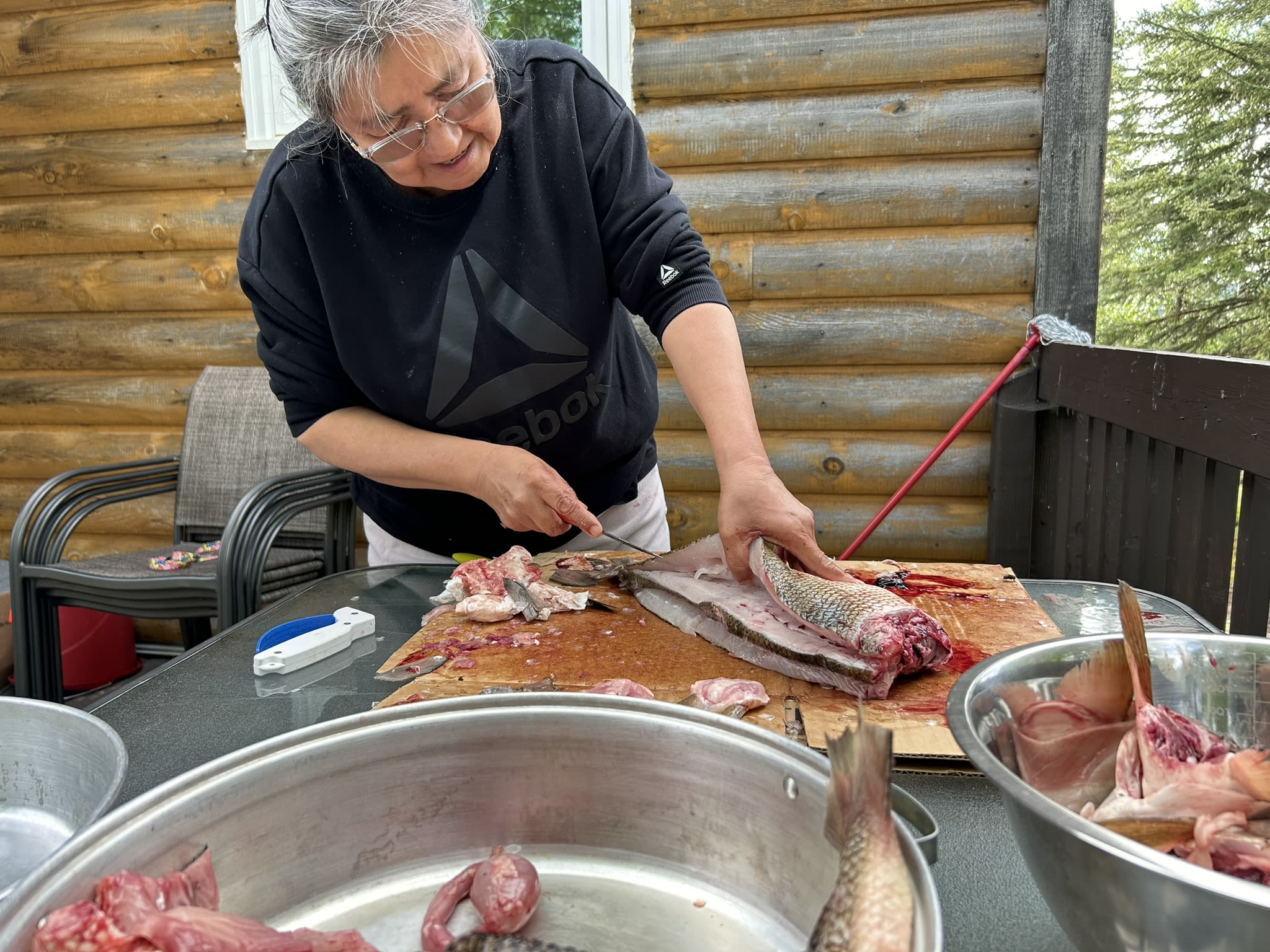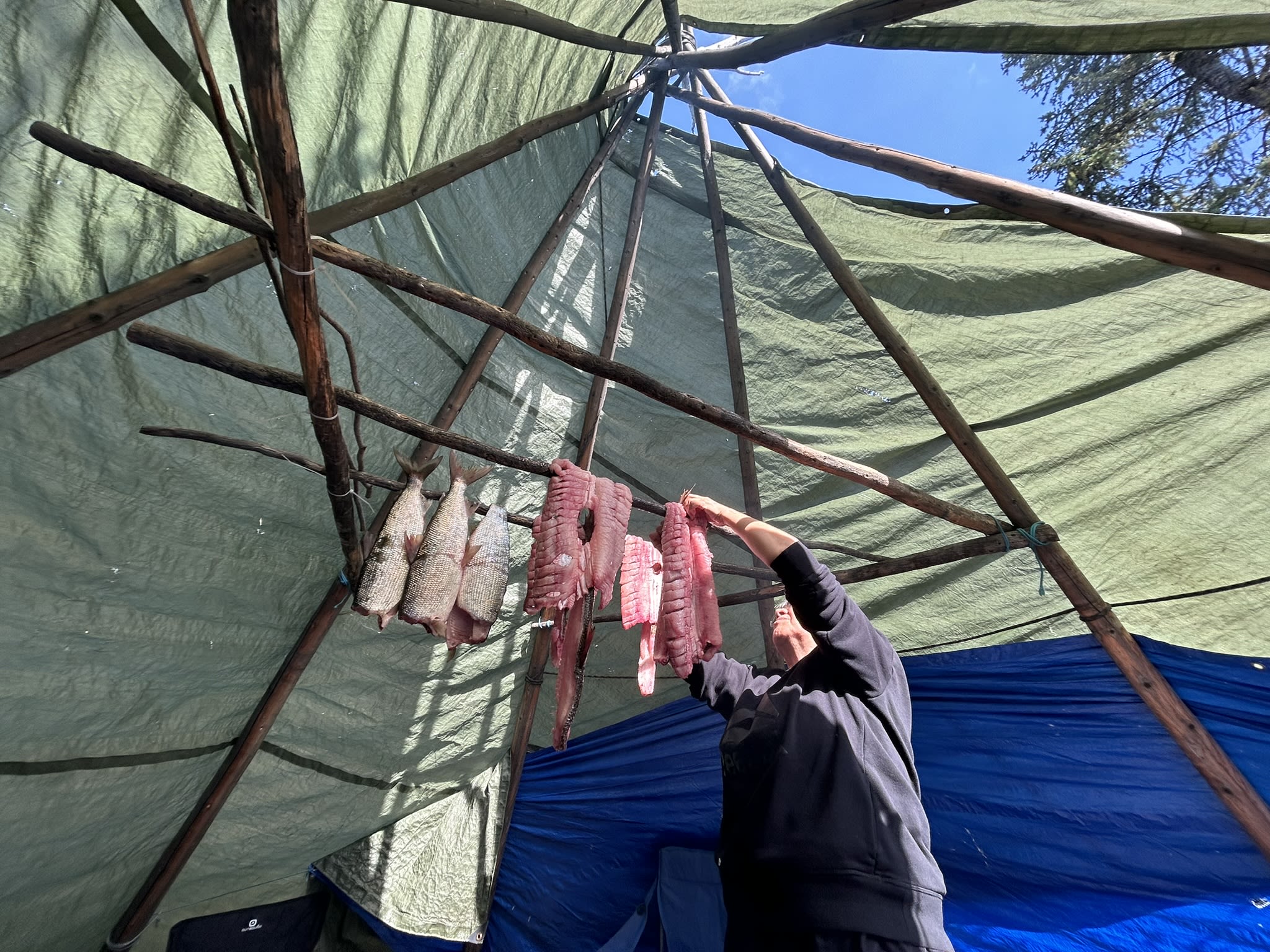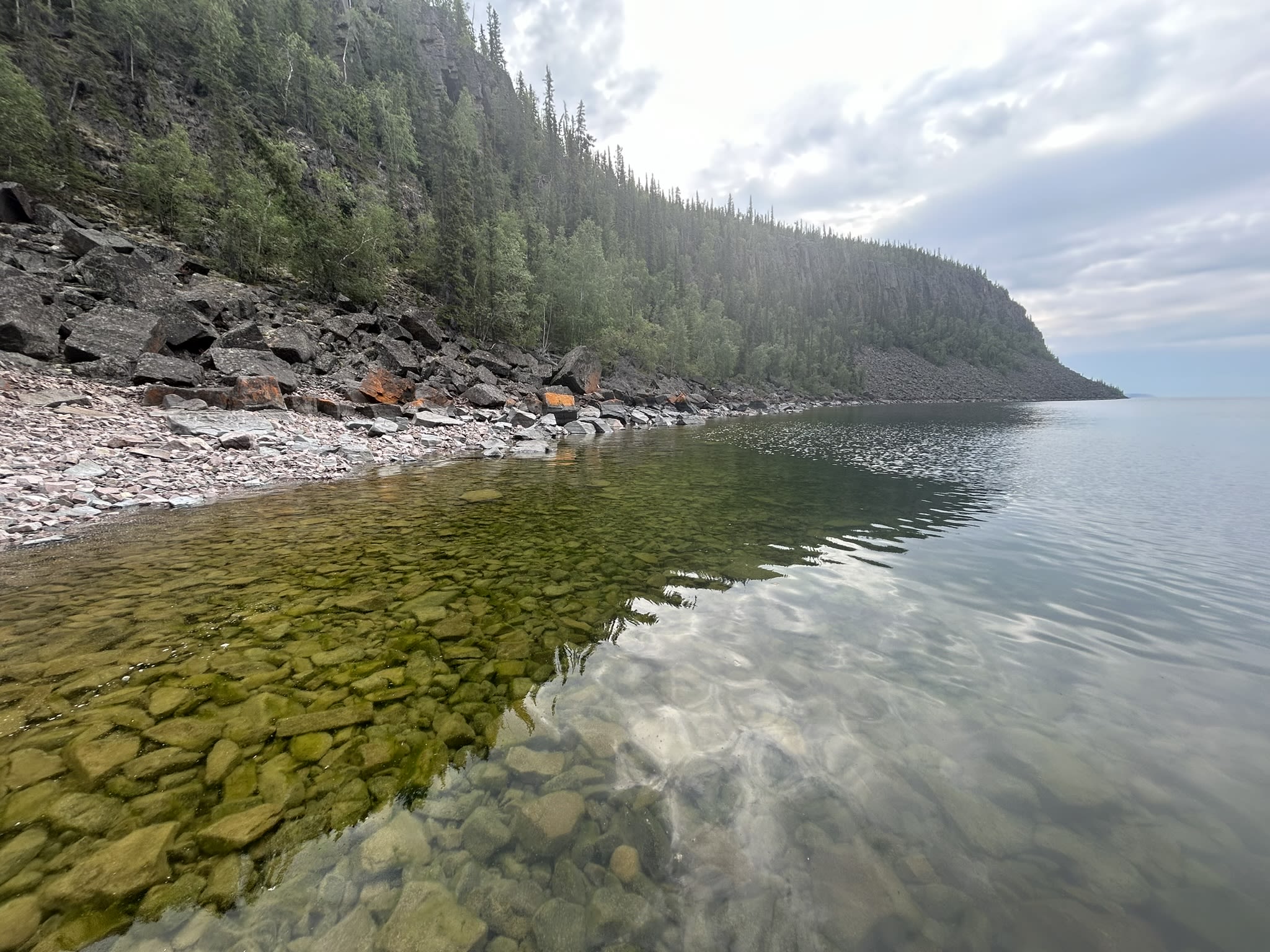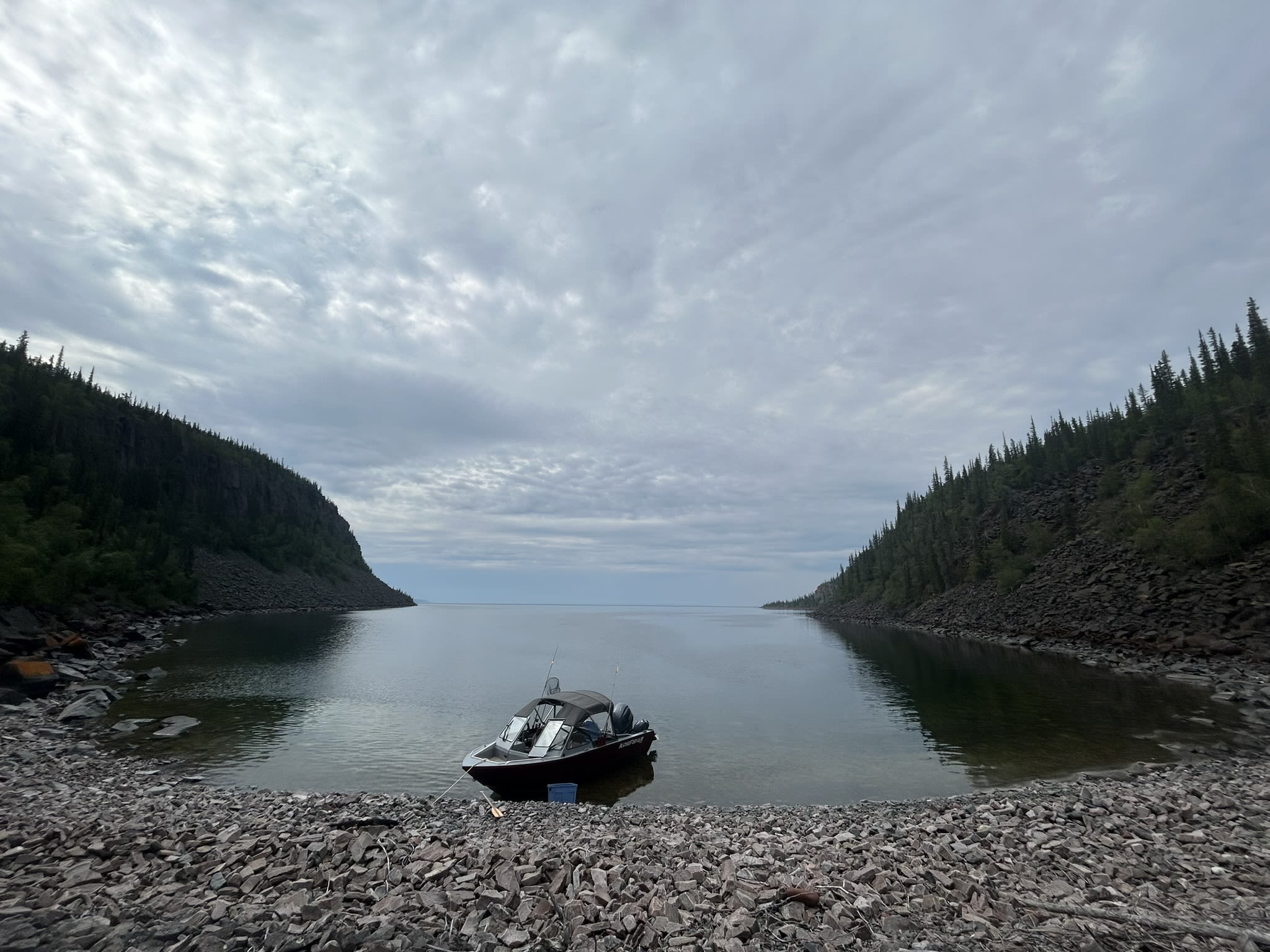Echoes of the Ancestors
A Taste of Thaidene Nëné

The sun blazes overhead, its light glinting off the water. Somewhere in the distance, muskoxen graze, though my eyes fail to spot them.
"Right over there. Do you see them?"
I squint at the distant horizon, straining to spot the wild animals that Dene Elder Ron Desjarlais has so effortlessly noticed.
We're in a boat, drifting along the East Arm of Tu Nedhé (Great Slave Lake), where the water plunges to depths of more than 600 metres, the deepest lake waters in North America.
But when I scan the rocky shore, all I see are the spindly trees of the taiga, blending into the endless stretches of water and rock. Shielding my eyes from the unrelenting sun with my hand, I scan the horizon again.
To me, it's an overwhelming expanse of wilderness, but for Ron, each feature of the land is like a familiar face. His eyes are trained to pick out the subtle movements and shapes hidden in the terrain.
Renowned for its dramatic cliffs, ancient rock and crystalline waters, East Arm's sheer scale and depth adds to the sense of isolation and wildness.
This is the Land of the Ancestors, Thaidene Nëné in the Dënesųłıné language — Canada's newest national park, and the first to be co-managed by Indigenous Peoples.
To Ron, it's simply home.

While Thaidene Nëné has only officially been a national park since 2019, it has been the homeland of the Dene for millennia.
Born here, Ron grew up fishing these storied waters and hunting on the land. He and his wife Shirley raised their three children in Łutsël K'é, his home community.
Now Ron shares the beauty of his home with visitors through his company Red Cliff Adventures.
I've come to the Northwest Territories to stay at Frontier Lodge, a remote, fly-in-only fishing lodge purchased by the Łutsël K'é First Nation in 2019, and to learn about the land from Ron.
Frontier's General Manager, Corey Myers, who has been at the lodge for well over a decade, says the local community has been instrumental in adding cultural value to the property. Visitors are now encouraged to come not just for the prized fishing in these deep waters but for the cultural immersion, offered by community Elders like Ron.
Corey has worked diligently with the community to add cultural touches to the lodge, such as naming each of the renovated cabins after a place of significance. Inside the cabins (and in the main dining area) are signs that showcase the Dënesųłıné language and quotes from community members.
My cabin is named Tthaili (Snowdrift River). The accompanying quote from Sara Boucher reads: "Elders treated the land like it was a living thing because it is. It feeds us, and offers everything for us to be happy and live a good life. Speak with respect always, carry it in your heart. The land knows you."
As I continue to squint into the distance, still struggling to see what Ron has already noticed with ease, he digs into his bag and hands me a small pair of binoculars.
"There," he says, pointing me in the correct direction.
As the view sharpens, I can finally make out the family of muskoxen — two massive, prehistoric-looking adults and two small, adorable calves.
Photo: Frontier Lodge/NWTT
Photo: Frontier Lodge/NWTT
"That's good eating," Ron tells me when I exclaim my delight at seeing the young ones. Then he laughs heartily as he sees the shock on my face.
The meat from fully grown animals is tough, Ron explains, which is why Dene hunters favour the tenderness of the young — good eating, indeed.
It is a phrase I'll hear often from Ron as he, and his wife Shirley, spend three days sharing their land, culture and food with me.

"So you came to see some muskox," Ron asks me on our first day out together. It is just the two of us in his fishing boat and I get the feeling Ron is trying to figure out why I came, alone, all the way from Toronto to Frontier Lodge when I have no interest in catching trophy fish.
"I came to hang out with you, Ron," I answer.
"Oh," he replies. "Good, good."
Silence.
"Hopefully I won't get you into any trouble," he jokes, breaking into a big grin.
The next morning, when he picks me up at the lodge, Shirley is with him.

Shirley, it turns out, is a delight and the perfect foil to Ron's more introspective nature. During the school year, she lives in Yellowknife where she teaches the Dene language to school children. Unlike Ron, she didn't grow up in Łutsël K'é but moved here as an adult after meeting her husband in high school (although they didn't date until reconnecting a few years after graduation).
Originally from the Mackenzie River area in the Northwest Territories, Shirley vividly remembers her first spring on the East Arm.
"I kept waiting for the ice to break up like it did back home on the river. It finally dawned on me that this big lake is different," she tells me. "Back home, the river would start to break up and everyone from my tiny community would line up along the banks and watch. It was very exciting."
The rocky shores around East Arm are etched with different stories, the history of a nomadic people that have been stewards of this land since time immemorial and are now working to preserve it for future generations.
Thaidene Nëné, where Ron, Shirley and I head now — after relieving the net Ron had set the night before of about a dozen fish and dropping them off for Elders in Łutsël K'é — is an Indigenous Protected Area.
Parts of the area have been designated a National Park Reserve, a Territorial Protected Area and a Wildlife Conservation Area through partnerships with Parks Canada and the Government of the Northwest Territories.
The Łutsël K'é remain stewards of the area as a whole.
On a short three-day visit, we are only able to scratch the surface of the vast land, which spans 6.5 million acres and represents the transition between boreal forest and tundra.


For the Dene, land and water conservation is a way of life. Our days in Thaidene Nëné are spent fishing (both by net, as is traditional, and by rod, where I clumsily catch, hug and release my first-ever fish, a trout) and berry picking.
It is too early in the year for cranberries, but we find tiny wild blueberries and, much to Shirley's delight, soft cloudberries.
Shirely Desjarlais harvesting cloudberries on an island in Thaidene Nëné.
Shirely Desjarlais harvesting cloudberries on an island in Thaidene Nëné.
"Come take a picture of these before I pick them all," she calls across the land to me. "I haven't seen these in about 10 years!"
I hurry across the lichen-covered land to where Shirley has discovered a large patch of the amber-coloured berries. They are sweet and tangy, juicy and soft.
The entire landscape feels surreal to me. I cannot quite get used to the soft yet crunchy feel of the moss and lichen that covers the ground, perfect food for the barren-ground caribou that share this land.
The berries look familiar but taste slightly different. Good eating, I think, as I pop another one in my mouth.
When it is time for lunch, we first pull into a beautiful cove but even as we begin to search for firewood, Ron keeps looking out at the horizon and shaking his head.
"The wind," he says, once again pointing to the horizon at something so obvious to him but a mystery to me.
He shows me how a long line along the water tells him that the wind is picking up. In these parts, where the water is so cold and deep, a capsized boat is deadly. If the wind got too strong, we'd be stuck in the cove for a while.
So we pack up and move to a different spot on a rocky shore about 10 minutes away. Just as Ron predicted, the water that had been smooth just a few minutes earlier was now choppy and rough.
We set up a typical 'shore lunch': freshly caught fish grilled over the fire, bannock (Shirley mixes the dough in a bucket and cooks it on cast iron pans) and soft baked potatoes that taste of our smoky fire.
Ron eating fresh fish eggs as he guts fish for our shore lunch right on the land.
Ron eating fresh fish eggs as he guts fish for our shore lunch right on the land.
As we are about to eat, Ron disappears and returns with an arm full of fresh spruce branches. We don't use any paper plates, everything is placed on the spruce and we dig in with our hands, pulling off pieces of fish and ripping off pieces of bannock. The only trash we need to pack out is the tin foil that had been wrapped around our potatoes.
We leave the remains of the fish in the branches 'for the gulls,' they tell me.
While we eat, I ask: If I wasn't here, would you eat the same way? They both nod.
"This is a typical lunch when we're on the land," Shirley says.
"That's good eating," Ron adds.

The next morning, Ron and Shirley take me back to Ron's net so we can harvest the catch. Today we will be spending the day in Łutsël K'é but first, the couple stops at a rocky outcrop to clean and gut the fish.
The gulls circle as they watch Ron and Shirley work, waiting for their turn.
"Good eating for them too," Ron says.
Ron and Shirley cleaning freshly caught fish on the land with the gulls circling around waiting to clean up what's left behind.
Ron and Shirley cleaning freshly caught fish on the land with the gulls circling around waiting to clean up what's left behind.
In Łutsël K'é, I get a short tour of the town where about 300 people live. It is quiet because many from the community are away at an annual gathering.
Ron and Shirley invite me into their home where Shirley busies herself cutting the fish for drying and smoking in their backyard teepee. It's been some time since she's done this work, she tells me, but it all comes back to her.
As I watch her expertly work her knife, she tells me stories of her childhood and her early years of marriage and motherhood. I feel a deep sense of being let in on something sacred.
Soon we have rows of fish hanging over the smoky fire, whole ones for smoking and prepared ones for drying.
As the fish hangs, Ron and Shirley cook lunch in cast iron pans over the fire. Pan-fried fish we'd caught that morning and a medley of potatoes and onions.
"That smells amazing," I can't help but exclaim, knowing what Ron's response will be.
Sure enough, he looks over at me expectedly.
"That's good eating," I say. He nods his approval.

The flight between Łutsël K'é and Yellowknife, the capital city of the Northwest Territories, is about 45 minutes. The next day, as the small aircraft — a Twin Otter — takes off from the tiny Łutsël K'é airport and flies low over the land, I catch a glimpse of the breathtaking expanse of the wilderness.
A patchwork of rocks and water.
From this height, the land looks barren, reminding me of Georgian Bay back in Ontario, where we camp each summer and my children splash in the small pools of water that gather between the rocks. But having seen it up close, I know the land is alive, teeming with animals, plants, history and the stories of her people.
By the end of my time in Thaidene Nëné, I feel like I've been woven, if only briefly, into the fabric of this land, a part of the stories that Ron and Shirley so generously share.
I am reminded of Sara Boucher's words in my cabin: "The land knows you."
And now, I think, it knows me too.
View from the airplane flying into Łutsël K'é
View from the airplane flying into Łutsël K'é
Red Cliffs of Thaidene Nëné
Red Cliffs of Thaidene Nëné
Ron harvests resin from a spruce tree. He uses it as a natural chewing gum.
Ron harvests resin from a spruce tree. He uses it as a natural chewing gum.
Getting Here
Frontier Lodge is located a short boat ride from the community of Łutsël K'é on the East Arm of Great Slave Lake in the Northwest Territories.
Accommodations are inside cabins and include all meals: breakfast and dinner at the lodge and lunch out on the land. While fishing will always be at the heart of Frontier Lodge experience, cultural immersion and guided tours of Thaidene Nëné are available and encouraged.
To connect with Ron, visit his website at Red Cliff Adventures.
Embrace Canada with Landsby
Landsby creates unique and immersive experiences that not only provide travellers with purposeful and enriching trips but aim to positively impact the communities being explored.







